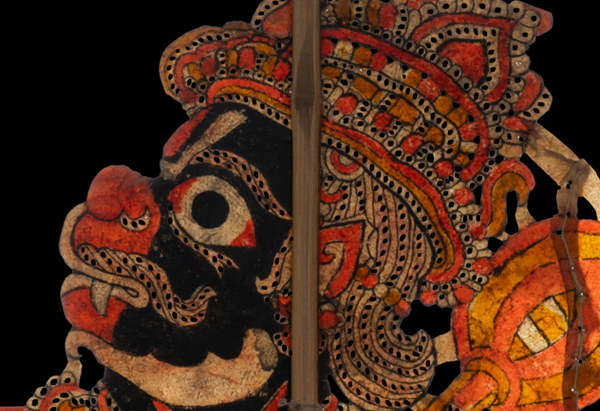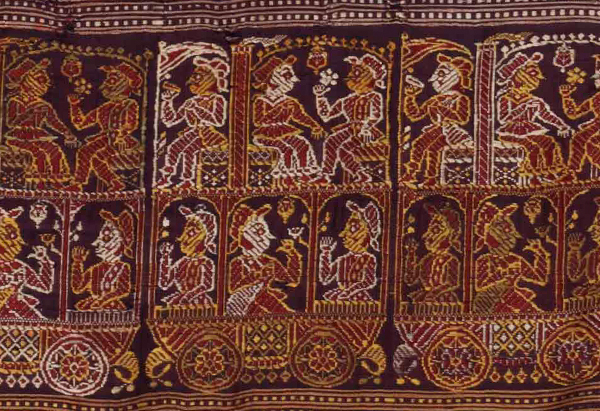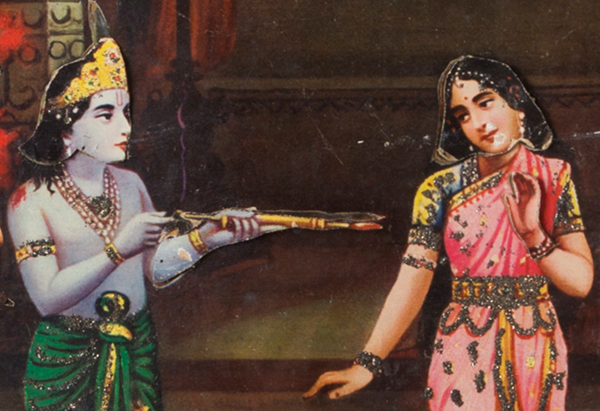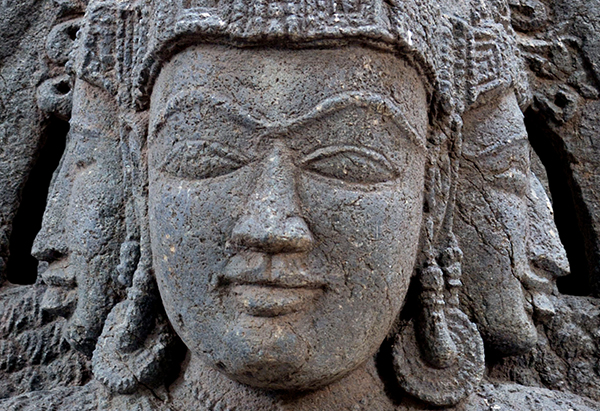
Disconnect from your surroundings and delve into the mood and essence of art with Sights and Sounds.
Sights and Sounds brings together sonic interpretations of six artworks in MAP’s collection created by Mumbai based company, BrandMusiq. Each artwork evokes a mix of emotions like fear, joy and melancholy, inviting you to perceive works of art sonically in order to empower an aesthetic experience through the act of listening.
The subtle integration of MAP’s MOGO®, or musical logo, threads through each composition.
As you navigate through this experience, we would like you to think about how you spend time with an artwork? What an artwork might sound like and whether our interpretation of a visual artwork changes with sound. Can sound reveal a new way of perceiving?
Using our MUSE, or ‘Musical Strategy Exercise,’ we first designed the unique sound of MAP that expressed the brand’s persona (Avatar) and key emotions (Rasas). The building blocks of this sonic identity system comprised a MOGOSCAPE® (sonic palette) and MOGO® (musical logo).
Our next challenge was to create a musical response to the six selected works of art. We subtly infused the MOGO® into every composition while expressing the respective Rasas evoked by the different works of art.
Rasa translates to "juice, essence, or flavour." First appearing in ancient Vedic literature, the Theory of Rasas has been an integral part of Indian art forms and refers to the emotional essence conveyed in any artistic work.
With the Theory of Rasas in mind, we commissioned a diverse range of musicians to respond to each artwork in a spontaneous outburst of creativity.
Each track was carefully composed to add a different dimension to the perception of the artwork, thus creating a unique sonic interpretation even while communicating the values and essence of MAP.
- BrandMusiq
ABOUT THE EXPERIENCE
Disconnect from your surroundings and delve into the mood and essence of art with Sights and Sounds.
Sights and Sounds brings together sonic interpretations of six artworks in MAP’s collection created by Mumbai based company, BrandMusiq. Each artwork evokes a mix of emotions like fear, joy and melancholy, inviting you to perceive works of art sonically in order to empower an aesthetic experience through the act of listening.
The subtle integration of MAP’s MOGO®, or musical logo, threads through each composition.
As you navigate through this experience, we would like you to think about how you spend time with an artwork? What an artwork might sound like and whether our interpretation of a visual artwork changes with sound. Can sound reveal a new way of perceiving?
Using our MUSE, or ‘Musical Strategy Exercise,’ we first designed the unique sound of MAP that expressed the brand’s persona (Avatar) and key emotions (Rasas). The building blocks of this sonic identity system comprised a MOGOSCAPE® (sonic palette) and MOGO® (musical logo).
Our next challenge was to create a musical response to the six selected works of art. We subtly infused the MOGO® into every composition while expressing the respective Rasas evoked by the different works of art.
Rasa translates to "juice, essence, or flavour." First appearing in ancient Vedic literature, the Theory of Rasas has been an integral part of Indian art forms and refers to the emotional essence conveyed in any artistic work.
With the Theory of Rasas in mind, we commissioned a diverse range of musicians to respond to each artwork in a spontaneous outburst of creativity.
Each track was carefully composed to add a different dimension to the perception of the artwork, thus creating a unique sonic interpretation even while communicating the values and essence of MAP.
- BrandMusiq
Credits:
Content Development: Arnika Ahldag, Vaishnavi Kambadur, Riya Kumar Graphic Design and UI: Abraham John, Joseph Suum Video editing: Shreya Chitre, MAP, Jagan Prem Kumar, OpEzee Collections: Madhura Wairkar, Clifford Jeffrey, Rucha Vibhute, Prachi Gupta, Patricia Trinidade, Priya Latha and Vineet Kajrolkar Anjaneya Animation: Annette Jacob Communications: Krittika Kumari, Nayantara Bharteeya, Debangana Kundu and Shaina Jagtiani Programming: Shilpa Vijayakrishnan, Surya HK, Ishwari Arambam, Mehreen Yousaf and Shruti Kondi Inclusion Manager: Kunal Mehta Alt text: Vaishnavi Kambadur We thank Team BrandMusiq, Jovian Soans for sound engineering and Media Minds for production of music in this exhibition.
Credits for Individual ‘Sonic Art’ pieces by Team BrandMusiq
Untitled, Ram Kumar - Concert/Alto Flutes by Rajeev Raja
Semi-Automated Portable Display Unit Depicting 'Rang Holi' - Composed and arranged by Uroovaak Vora - Percussion Vinayak Netke
Baluchari sari (detail) - Composed by Hitesh Dhutia/Yash Mall - Guitar: Hitesh Dhutia - Keys, Synthesisers: Yash Mall - Tabla/Percussion: Vinayak Netke
Francis and Bobby D'souza in their bedroom, Parra (‘Edge of Faith’ series, published 2009) Composed by Rajeev Raja - Blues Harp: Rajeev Raja - Guitar: Hitesh Dhutia -Hammond Organ: Yash Mall
Anjaneya - Composed and arranged by Vinayak Netke - Flutes: Rajeev Raja - Guitar: Hitesh Dhutia - Percussion: Vinayak Netke
Brahmani - Composed and arranged by Chandana Bala - Vocals: Chandana Bala - Keys: Uroovaak Vora
Prabuddha Dasgupta, Francis and Bobby D'souza in their bedroom, Parra (‘Edge of Faith’ series, published 2009), 2006
Archival pigment print, H. 81 cm, W. 111.5 cm, PHY.12294
Two men sit closely together on the edge of a bed, captured in a moment of intimacy and closeness. Whether the two men are brothers, friends or lovers remains an unanswered question. Time, in this image, stands still. The bare floor of the room, the worn-out interiors and stillness suggest time that is paused.
Francis and Bobby D'souza in their bedroom, Parra is part of the series Edge of Faith. In this series of photographs, Prabuddha Dasgupta documents moments of melancholy and nostalgia, but also the tenderness of interpersonal relationships within the Catholic community of Goa.
Goa became an independent state in 1987, after more than 500 years. As a newly formed state, it struggled between holding onto a religious and a colonial identity, and of a new state and national identity.
While this image might appear magical to us, the viewers, it might be a very real and common moment to Bobby and Francis. Yet, it also allows us to witness the intimacy shared between them and the photographer.
The picture of Francis and Bobby D'Souza in their bedroom displays Karuna (compassion), Sringara (love), and Shanta (peace). Although there is a lot of tenderness and affection, there is also a sense of melancholy. We expressed this musically with the Blues Harp backed by a simple guitar and Hammond organ to accentuate the feeling of joy in sadness.
Anjaneya, Andhra Pradesh or Karnataka, India, c. 1970
Animal hide painted and incised, bamboo sticks, H. 66 cm, W. 50 cm, SCU.00066
Is Hanuman on his way to fetch medicinal herbs for Sita or is he flying to search for Sita in Lanka? In the case of shadow string puppets, one string puppet such as the character of Hanuman, could be part of many scenes that puppets bring to the enactment of mythologies in Southern India.
Shadow theatre is believed to be one of the earliest performance arts in which humans are sutradhars or “pullers of strings''. Interpretation of chaya or shadows by a group of puppeteers, singers and actors are not only a form of entertainment; these all-night performances can also serve as a reminder of one’s ancestors. The actors modify their voices to dramatize scenes and deliver dialogues for hours using 100 or more puppets per story. Here, Anjaneya’s heroic nature would be emphasized through sounds of thunder, rain and intense battles.
Leather, hide and deer skin are used to make these puppets — the makers’ creativity lies in choreographing movements of the puppet to match with their personalities. The Hanuman puppet is the most agile and dynamic, while a Ravana puppet would have swift movements. Most of them face sideways with one eye popping out. Their most significant features, like Hanuman’s tail or gadha, are highlighted when the puppeteer manipulates form with shadows behind a white sheer cloth like a dhoti or a sari.
This shadow play of puppets is known as tholu bommalata in Telugu and togalu gombe aata in Kannada, and are also made in Kerala and Orissa.
The animal hide puppet of Hanuman, "Anjaneya," elicited rasas of Veera (courage), Hasya (playfulness) and Adbhuta (surprise). Staying true to its roots, we wanted it to have the sound of folk music and puppet shows.
Baluchari sari (detail), Undivided Bengal, India, early 20th century
Silk, L. 454 cm, W. 113 cm, TXT.00559
We know that the baluchari came from Baluchar located in present day Murshidabad. The unusually long pattern on one end shows us that the weavers were interested in weaving their local surroundings into the cloth. How did Baluchar and it’s neighbouring areas show up in designs of steam engines, in figures of Nawabs, flowers and frames?
The rectangular cloth in typical baluchari colours like purple, gold and silver contains a pattern of kalkas, an auspicious almond shaped design which is also found in important textiles from Bengal like jamdani and kantha. The arrangement of motifs tells us that the sari was divided in a manner which is similar to terracotta temple architecture that was introduced by Jain merchants. These merchants were traders of silk cloth and collected baluchari textiles as artworks. The brocade on baluchari was woven on a jacquard loom or a draw loom, with weavers making the patterns much larger on the pallu. While most Bengali saris were draped vertically, baluchari might have been draped horizontally like the ones in Gujarat. Because of a concentration of silk traders, Bengal attracted Portuguese merchants and traders from the East India Company to settle there. We see this in the form of 18th century technologies such as the steam engine depicted above. Inside the engine, we see mysteries of life in Bengal, people exchanging flowers, drinking wine and enjoying the journey.
The rasas we identified for the "Baluchari Sari" were Sringara (love), Hasya (happiness), and Karuna (caring). Since the baluchari style originated in Bengal, and this fragment portrays a scene of European people travelling, we combined the sounds of Bengal, the clicking of the loom similar to the rhythm of a moving train and western orchestral elements. The delicate plucking of the guitar was a tribute to the intricacy of the sari’s weave.
Semi-automated portable display unit depicting 'Rang Holi', Chonker Art Studio, Bombay (Mumbai), India, early 20th century
Oleograph prints, wood, fabric and metal fixtures, H. 42.1 cm, W. 54.5 cm, D. 12 cm, POP.00774
How did one create movement within a still image? What were some of the ingenious techniques that makers used to “animate” a work in the early 20th century?
The arrival of lithography in the 1800s allowed for the democratization of calendar art and initiated a culture of mass produced imagery in India. Commercial presses established during the later half of the century produced chromolithographs, particularly images of gods and goddesses. The style of these prints was hybrid as they often blended Indian and European aesthetics.
Based on an artwork by R.G. Chonker, this portable unit contains a print showing a scene of holi. Set within a palatial backdrop, we see Krishna in a green and yellow dhoti besides gopis dressed in colourful saris. A closer look at the jewellery and clothes shows embellishments with hints of silver glitter.
As the title "Rang Holi" suggests, Krishna and the gopis are celebrating holi, a festival that also celebrates the divine love between Krishna and Radha. The strewn colours on the ground, the golden pichkaris or water guns and the coy look of a seated gopi all add to this sense of joy and celebration.
A turn key mechanism at the back of the unit brings the print to life. Some of the figures have their heads and hands cut out and then pasted back onto the print to allow for visible movement. Once it is wound up, you see subtle movement such as the nodding of heads and slight motion of the hands and pichkaris.
For the display unit depicting "Rang Holi," Raag Bhimpalasi was used to depict the Sringara Rasa (romantic mood) on the one hand and Hasya (joy/playfulness) on the other. We used instruments such as the Sitar and Dhol, along with the traditional ‘Holi Hai’ chant, to create a fun interpretation that was celebratory, while highlighting the coyness of the gopis with Krishna’s wistful flute.
Brahmani, 10th century, Karnataka, India
Grey steatite schist, H. 70 cm, W. 44 cm, D. 22 cm, SCU.00234
Brahmani, personifies Shakti or the energy of Brahma and belongs to a group of seven or eight goddesses called the matrikas or mothers. Like Brahma, the mother goddess Brahmani has four heads, although we only see three in this sculpture. Seated on a lotus, she is depicted with four hands which either show gestures or hold attributes. In her upper left hand, she holds an akshamala, a rosary of beads, that are also used in meditation, while her lower right hand is in abhaya mudra, the gesture of protection. Her upper right hand holds a kamandalu, a water-pot while her lower right hand is in varada mudra, the gesture of generosity. According to the text Devi Mahatmya, in a battle scene, Brahmani is described as "slaying with water sprinkled from her kamandalu".
There are many origin stories that surround the matrikas. In one such story, they are said to help Devi, the supreme goddess, in her fight against the demons Nishumba and Shumba. Another origin story posits them as the collective mother of Skanda, the son of Shiva. While some matrikas are known to have a fierce side, this Brahmani is peaceful, almost serene in appearance, embodying saumya, the gentle. In a Hindu temple, she sits under a palash tree with sacred leaves and meditates; the presence of her vehicle, a white swan, intensifies her tranquil nature.
For the sculpture "Brahmani," the rasas were Sringara (devotion) and Veera (courage). Since Brahmani personifies the shakti of Brahma, we based this piece on Brahma's favourite Raag ‘Vachaspati’. We delivered it in a typical Carnatic vocal style since the sculpture originates from Karnataka.
Ram Kumar, Untitled, 1976
Oil on Canvas, H. 178 cm, W. 102 cm, MAC.01040
An inner turmoil that expresses itself through colour; a quest for language that morphs into abstract forms; thoughts on colonial India that are transformed into lines, strokes and layers.
These are some ways in which Ram Kumar uses his painting to convey complex feelings that he and modern artists like F.N. Souza, S.H. Raza and M.F. Husain experienced while shaping the post-colonial artistic identity of India. While Ram Kumar initially painted figurative works in the 1940s and 1950s, he turned towards abstraction at a later stage in his career. This painting, with hues of red, is not meant to be understood. Instead, Kumar intends for us to “look into ourselves” and introspect about how we relate to our own self by using his work as a medium. With this work, we can choose to embark on a spiritual journey while asking questions like is this a cityscape of despair? Or an abstract quilt of merging stitches?
The painting by Ram Kumar evokes fiery imagery, a sense of Bhaya (fear) and Raudra (anger) with hints of Karuna (compassion), which finally leads to Shanta (peace). The two flutes in a ferocious jugalbandi build towards a crescendo, finally culminating in a sublime response.





